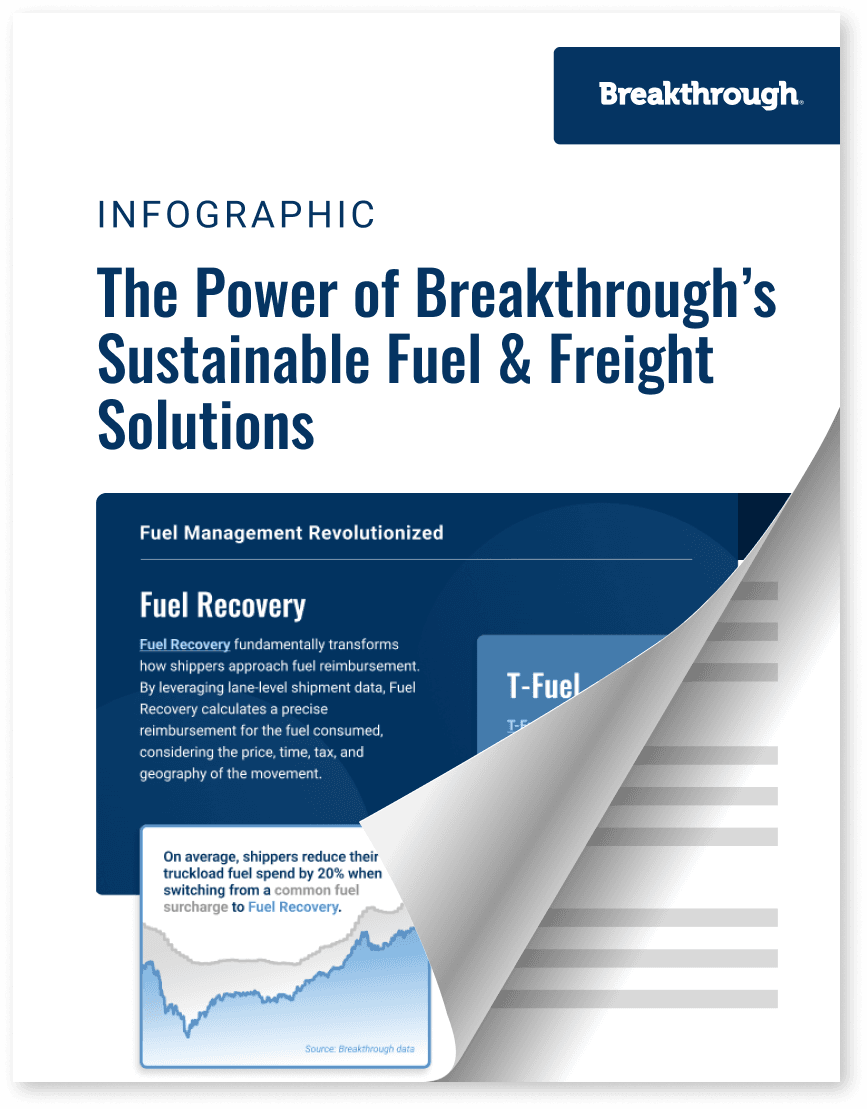The Power of Breakthrough's Sustainable Fuel and Freight Solutions

Freight
3 min read
July 17, 2024
Market Events
4 min read
July 16, 2024
Market Events
3 min read
July 8, 2024

6 min read
November 13, 2020

Share:
As the continued influence of the novel strain of coronavirus (COVID-19) influences economic activity for businesses, others are facing very different challenges. Small businesses, the restaurant industry, tourism, and travel have continued to pivot in the new normal as social distancing protocols and mask mandates limit capacity or force shutdowns completely and many U.S. citizens are opting to stay home to prevent further spread.
For the commercial transport industry, these changes have manifested differently across freight verticals. While durable goods and other non-essential items were significantly suppressed at the start of the pandemic, a COVID-19 economy translated into an influx in other industries. Products that enable self-sufficiency from the comforts of home and items protect essential workers have increased significantly and remain at historic highs. Breakthrough’s data, which supports over 60,000 daily freight movements, supports this assertion.
In March and April consumers emptied store shelves to stock up on essentials, like toilet paper, health products, cleaning supplies, food products, and other consumer packaged goods.
Initially, COVID-19’s impact on consumer-packaged goods, food and beverage, paper and packaging, and retail goods spiked and have retained most of their strength throughout the Breakthrough Ecosystem. Freight demand for these nondurable goods rose nearly 23 percent at its peak compared to the prior year’s level and have remained above 2019 levels ever since, even as the pandemic endures nine months later. For these sectors, this behavior surpassed 2018 levels when the U.S. was economically thriving.

For others, primarily nondurable goods, volumes dipped significantly. This dip reflects a shift in consumer purchasing patterns that stem from a fear of an unknown economic future. This stark decrease in volume will inherently alter the dynamics of these manufacturers’, retailers, and shippers’ freight procurement strategies.
When much of the commentary in the marketplace is concerned about a stalled labor market and slowed economic activity, what can shippers expect for their supply chain as we begin to stare down 2021?
Months after COVID freight impacts manifested, uncertainty across the globe continues, with an end of the virus still undetermined. The forward-buying consumer behaviors that manifested in freight volume surges early have receded, though remain above typical levels.
As the variability in consumer demand remains in flux, each link across a good’s journey to the store shelf or end-user becomes more unpredictable, and transportation is not immune to this phenomenon. This uncertainty has led to a myriad of challenges in forecasting accuracies and planning in times of disruption. For shippers that procure capacity based on an annual RFP cadence, this ongoing uncertainty has left those freight contracts in disarray.
Learn how to navigate massive fluctuations in diesel fuel prices, and how your fuel reimbursements are costing you millions in unnecessary costs here.
The most successful shippers will navigate the challenges of meeting volume requirements and procuring capacity with an agile and data-based strategy that reimagines how we think about freight contracts.
It is important to keep the uniqueness of the COVID-19 outbreak at the forefront of analyses of current freight trends. Consumer spending for services could remain weaker than expected for a longer period than would be typical under normal recessionary circumstances. This opens the door for additional spending for physical goods, especially if another round of stimulus is enacted in the first quarter of 2021.
That being said, we have seen freight demand shift at different rates for both nondurables and durable goods.

While freight demand for nondurable goods spiked due to consumers stockpiling essential household goods, freight demand for durable goods responded oppositely. In the Breakthrough network, durable goods did not have an initial spike but saw a decrease of nearly 42 percent year-over-year, which can be seen in the red line’s deep fall off in the chart above.
This behavior is common in durable goods space when the economy enters a downturn. With mass layoffs and furloughs, consumers limit their spending on big-ticket items like appliances and home improvement. This is also reflected in an uptick in personal savings rates.
The uncertainty and the sharp reaction to the pandemic seen in the labor market pushed freight demand for durables into a deeper fall, before starting its profound recovery.
The durable goods recovery in the Breakthrough network was largely due to the strong rebound seen in automotive and housing market segments. As these industries began their recovery in July, so did freight demand supporting the supply chain of those industries. Some of the strongest players in this space were automotive parts, construction materials, and other durable goods that are typically purchased to maintain and renovate a house.
Learn more about consumer behavior and the relationship between durable and nondurable goods in an economic downturn here.
Looking ahead to the next six months, we expect freight demand to remain robust based on the sustained shift of consumer spending toward goods rather than services. An interruption to this trend is not expected until COVID-19 is controlled, and consumers are willing and able to shift some spending back to services.
This spending shift created a prolonged peak import season leading to demand surges across major U.S. port cities. U.S. imports maintained substantial year-over-year volume increases in September, including over 12 percent growth at the Port of Long Beach. Strong import numbers through September were driven largely by retailers rebuilding inventories ahead of the holiday season.
We expect freight demand to slow during the second half of the fourth quarter and entering 2021. These expectations are in place because of seasonal freight demand patterns that materialize through import volumes and consumer spending around the holidays.
One unknown that may keep freight demand stronger for longer is the next round of fiscal stimulus. The timing of further stimulus aid and perhaps supplemental unemployment insurance remains unknown, but we continue to expect further financial support.
The persistence of COVID-19 will likely continue to be the largest piece of uncertainty and volatility in a shipper’s supply chain. Recent spikes in virus cases in the upper Midwest and other regions that are typically impacted by influenza season, present headwinds for consumer sentiment and, ultimately, spending.
Uncertainty is the key tenet of most reporting related to freight and COVID-19, but when held against market fundamentals and accurate, complete data the outlook becomes clearer.
Staying in tune with changes in the market is in the best interest of your transportation network, and shippers who position themselves to quickly adapt with agility will ensure they are keeping pace with and surpassing their competitors.

3 min read
July 17, 2024
Maximize transportation efficiency with cohesive fuel and freight strategies. Discover the power of enhanced visibility, cost-effectiveness, and sustainability.
Read more
4 min read
July 16, 2024
Discover how the recent elections in Mexico and the EU are expected to influence energy policies, fuel prices, and dynamics in the transportation sector.
Read more
3 min read
July 8, 2024
Understand the state-specific changes in diesel tax rates and explore strategic solutions for shippers to accurately calculate fuel reimbursements to carriers.
Read more